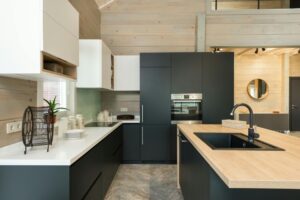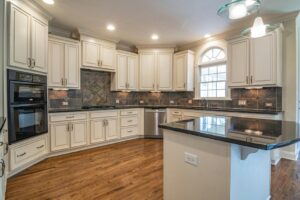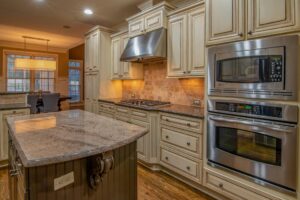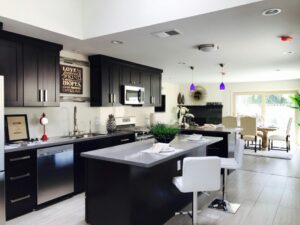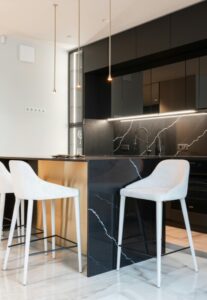Importance of Kitchen Design
The kitchen plays a critical role in every home. It serves as the heart of the house, where families gather to cook, eat, and socialize. Consequently, its design greatly influences a home’s overall value.
Role of The Kitchen in A Home
Traditionally viewed merely as a place for preparing meals, modern kitchens have evolved into multi-functional spaces integral to daily life.
Impact on Home Value
A well-designed kitchen can significantly enhance your home’s market value. Potential buyers often pay particular attention to this area during property viewings.
Factors To Consider In Kitchen Design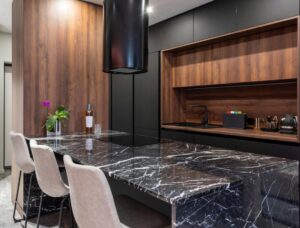
Designing your dream kitchen requires thoughtful consideration of several factors including space layout, functionality, aesthetics, and budget constraints.
Space And Layout
Size Of The Kitchen
Kitchen size should be proportionate to the overall house size while accommodating all necessary appliances and features comfortably.
Position Of Appliances And Furniture
Strategic placement optimizes efficiency and ensures smooth movement within the space.
Functionality
Ease Of Movement
Your kitchen layout should facilitate easy access between workstations like stove-top cooking areas or sinks.
Storage Solutions
Smart storage solutions help maintain an organized workspace free from clutter.
Aesthetics
Color Schemes
Color choices set the mood and influence the perception of room sizes – light colors make rooms appear larger whereas dark hues create cozier atmospheres.
Material Choices
Quality materials contribute durability besides aesthetic appeal but remember they also affect costs incurred.
Budget
Cost Of Materials
Different materials come at varying price points; selecting cost-effective options allows you to remain within budget without compromising quality too much.
Labor Costs
Don’t forget labor expenses when calculating total expenditure required for renovation projects.
Popular Kitchen Design Styles
Today’s homeowners enjoy an array of styles ranging from modern minimalism through rustic farmhouse looks to chic industrial themes depending on personal tastes or existing architecture surrounding spaces.
Modern
Sleek, streamlined, and functional defines the modern kitchen style.
Traditional
Elegant and timeless, traditional designs evoke a sense of history.
Farmhouse
Farmhouse kitchens exhibit warmth and comfort with their vintage charm.
Industrial
The industrial design trend showcases raw materials for an urban, edgy look.
Key Elements In Kitchen Design
Every element contributes to your overall kitchen design – cabinets, countertops, appliances, and lighting being key among them.
Cabinets
Types Of Cabinets
Cabinet types range from base models standing on floors or wall-mounted versions through tall pantry styles providing additional storage space.
Cabinet Materials
Wood remains popular due to its natural beauty; however, metal and glass alternatives provide sleek modern aesthetics too.
Countertops
Types Of Countertops
Countertop options include slab surfaces like granite or quartz as well as tile and laminate variations. These offer affordable price points with durability and resistance against heat, stains, and scratches, enhancing the visual appeal of kitchens significantly.
Countertop Materials
Material choice dictates both functionality and cost. Different materials have unique benefits and drawbacks. Careful selection is required to meet individual requirements within set budgets, ideally after consulting professionals or industry experts.
Appliances
Essential Kitchen Appliances
Appliances form an integral part of every kitchen. Choosing the right ones depends largely on personal cooking habits and preferences, besides budget constraints. Capacity, features, brand reputation, quality, and longevity are important considerations when selecting appropriate machines to enhance utility, convenience, and usability.
Appliance Placement
Strategic placement of essential appliances ensures easy access, improved efficiency, and overall design harmony. This enhances unity, balance, orderliness, organization, neatness, cleanliness, hygiene, and safety.
Lighting
Types Of Lighting
Incorporating various types of lighting, including task, ambient, and accent lights, can greatly enhance the functionality and aesthetics of your kitchen.
Lighting Placement
Placement is crucial in ensuring that every area of the kitchen is well-lit, making tasks easier while also improving safety.
Tips For Designing A Kitchen
When designing a kitchen, there are several tips you can follow to ensure that your project is successful.
Planning And Research
Before beginning any kitchen redesign, it’s important to plan and research. This involves determining what you want in a new kitchen, setting a budget, and exploring different design ideas.
Seeking Professional Advice
Consulting with a professional designer can be incredibly helpful. They can provide advice based on their experience and expertise that could save you from making costly mistakes.
Considering Future Needs
Consider future needs when designing your kitchen. For example, if you plan on expanding your family or aging in place, these factors should influence the design decisions you make today.
Common Mistakes In Kitchen Design
When planning a new kitchen design, it’s essential to avoid common pitfalls which could impact functionality or aesthetics negatively.
Ignoring The Kitchen Triangle
The arrangement of the sink, stove, and refrigerator – known as the ‘kitchen triangle’ – influences efficiency significantly. Ignoring this crucial layout principle may lead to an impractical kitchen space.
Insufficient Storage
Lack of storage leads to cluttered countertops, affecting productivity adversely. Ample storage provisions must always be included within designs.
Poor Lighting
A poorly lit room impairs visibility, leading to difficulties during meal preparations. Ensure adequate lighting solutions are incorporated throughout spaces, ensuring bright, inviting kitchens that are easy to work within.
Conclusion: The Value Of Good Kitchen Design
Kitchen design holds great importance beyond aesthetic appeal alone. It directly impacts daily life quality by enhancing functional ease with user-friendly features combined with appealing visual elements. This creates ideal environments for cooking, socializing, and relaxing, making every moment spent within the kitchen truly worthwhile, meaningful, and fulfilling.
FAQs
- What are some factors to consider in kitchen design?
- Space and layout, functionality, aesthetics, and budget are key factors to consider when designing a kitchen.
- What is the importance of good kitchen design?
- Good kitchen design can enhance a home’s market value, improve functionality in meal preparation areas, offer efficient use of space, and provide an aesthetically pleasing environment.
- How does the placement of appliances impact my kitchen’s function?
- Strategic appliance placement can optimize efficiency while ensuring smooth movement within the space. The arrangement between your sink, stove, and refrigerator – known as the ‘kitchen triangle’ – should be kept unobstructed for maximum efficiency.
- Why should I consult with a professional designer?
- A professional designer has expertise that could help you avoid costly mistakes or oversights during your redesign project. Their experience enables them to foresee potential issues related to function or aesthetics before they occur.
